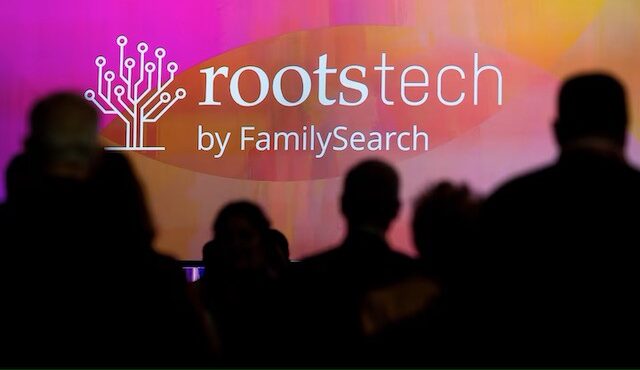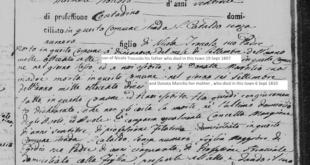I haven’t taken a trip for genealogy purposes for some years. I used to go to Salt Lake City for one week a year to do research on microfilm, but now that those films are available on FamilySearch.org, I don’t need to spend the money to fly and stay at a hotel anymore.
However, I did fly to SLC for a conference called RootsTech, which is a huge gathering of genealogists and computer tech people. Unlike conferences hosted by the Federation of Genealogical Societies or the National Genealogical Society, which are designed to link up local genealogy groups and train them on how to build larger local organizations, RootsTech is more about teaching us how to best use technology in our research.
Approximately 1,300 people attended the conference in person from Feb. 29 to March 2, 2024. I don’t think the figures are in yet for 2024, but over 3 million people registered to attend virtually. So why physically go at all? Because there were dozens of presentations that were only available in-person. Also, there was a huge exhibit hall with every major genealogy website and many national groups represented. If you have been to giant trade shows at McCormick Place, you have an idea of what the exhibit hall in Salt Lake City’s Salt Palace was like.
There were nearly 400 presentations available both in-person and on-line through the website www.familysearch.org/en/rootstech. There was a great phone app that helped you select the presentations you wanted to attend. You could select by speaker name, topic and skill level, and the app listed which presentations were ONLY in-person, which is very helpful.
The main difference between this conference and others is that an NGS conference has speakers who tell you how to visit the National Archives, or a local courthouse in Virginia, to find records you cannot get anywhere else. RootsTech presentations connected people with genealogy websites and/or family tree software. Some genealogists work very hard to persuade us that we should visit libraries and archives, and this is all required of those who research in the U.S. for very old documents that have not been released online. For those of use researching Italy, it is not so simple to hop the next flight to the motherland and start asking the clerks for their record books.
Each of the three days had classes scheduled from 8 a.m. through 5 p.m., usually with 10 different presentations at any given time. So no matter what, there was almost always more than one place that we wanted to be, but we had to pick only one. So I got together with some colleagues I knew from Illinois and we worked out a schedule that each of us would attend a different session, rather than all four of us sitting through the same lecture. That way, each of us took notes and could tell the rest of us what we missed. This system worked very well for us, especially because most of the in-person presentations specifically forbade video or even photos of the PowerPoint screens. Understandably, these presenters do not want others to steal their content and give presentations locally. Many presenters make a good living from their speaker fees and they shouldn’t be undercut by someone who posts the entire lecture on YouTube from their phone video.
So what kind of presentations were there? A quick summary of the topic areas:
FamilySearch.org
There were any presentations in the classrooms, plus many more short ones on the exhibit floor about all the ins and outs of my favorite topic in the column.
Achieving certification
These lectures explained the process for applying to the Board of Certification of Genealogist, which reviews your research, assigns you projects and after a very thorough review, potentially bestows the certification CG, which you can sign at the end of your name. This can lead to more lecturing opportunities and higher fees for doing professional research for clients. Many who apply do not receive the CG. It takes about a year to complete the requirements.
Researching in various countries
Many presenters talked about research in Germany, Italy, Ireland, Poland and many other countries. Most of them made sure to show the latest websites that bring data from those countries to us at home.
DNA
The science of taking a DNA test to try to connect to relatives keeps growing. Many genealogy sites sell DNA test kits directly, such as Ancestry.com. Other companies will allow you to submit your results to them free of charge, and they try to link you to their own family data and other testers. There were a number of presentations about how to evaluate a DNA connection to determine how you and the other person are related.
AI
The fastest growing segment of genealogy is the burgeoning AI technology. FamilySearch is starting to use AI to read handwritten records to index them. Since there are literally billions of unindexed records out there, AI can do this process much quicker than humans. Obviously this is still in the beginning stages but people are very excited by the possibilities. Most of the major genealogy websites gave presentations explaining how they were going to be in the vanguard of AI in the near future.
Case Studies
Many presenters took a specific problem they had, where there was no primary source such as a birth record, and the secondary sources (family Bible, letter from a cousin, death certificate) did not agree on the person’s birthday, and showed the websites and archives that had to be visited to settle the question.
In all, I attended a very helpful series of lectures on topics that I need to learn. I hope to play video of other presentations that I had to miss while I was there. But I also “worked” the exhibit hall. In other words, I had a list of problems or suggestions for some of these websites, and I went to the exhibit booths to ask for the tech person who would be able to work with me. I would ask them to find a certain film on familysearch, and they wouldn’t be able to find it using their search page. As the frustration mounted, I could persuade them that they need to make some adjustments to the search page. Whether those changes will be made is anybody’s guess, but I made my point to people who are part of the engineering teams that write these websites.
There are a lot more presentation topics that would drag this column on interminably, so if you want to see the list of all of them, and how to view any that are available for viewing, visit www.familysearch.org/en/rootstech
 Fra Noi Embrace Your Inner Italian
Fra Noi Embrace Your Inner Italian







